

Building a Two-Can Bioreactor. Purpose Two-can bioreactors are designed to be used as small-scall indoor composting units for families, and for composting as an educational tool in the classroom.
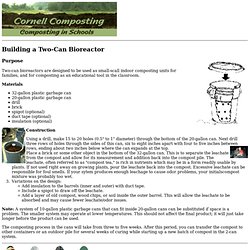
Materials 32-gallon plastic garbage can 20-gallon plastic garbage can drill brick spigot (optional) duct tape (optional) insulation (optional) Construction Using a drill, make 15 to 20 holes (0.5" to 1" diameter) through the bottom of the 20-gallon can. Www.backyardgardener.com/compost/RCO_files/RotatingBarrelComposter.pdf. How to Build a Tumbling Composter: 11 steps (with pictures) Edit Article Edited by Tom Stricker, James Quirk, Tom Viren, Sondra C and 28 others One of the keys to composting is aeration.

The bacteria need oxygen to carry out the aerobic respiration that creates rich compost. Good Earth Worms - Iceweasel. Composting - How to Make Compost - All about Making Compost. Compost in 14 -21 days & How to make a Tumbler Bin Composter. Composting: A timetable. Everyone knows that composting your fruit and vegetable scraps and other biological material is much better than sending those scraps to the city dump, where they would turn into methane gas.

But one thing people usually don't consider when starting a compost pile is how long it will take to turn into ripe compost. Here is a simple guide to give you an idea of how long it will take, using different composting methods. Hot Turn: 20 Days Hot turn piles are the most labor intensive and have more demanding basic requirements, but they produce finished compost much faster than other methods. Your compost pile must measure at least 3'x3' and have the proper proportions of carbon to nitrogen (brown stuff to green stuff, which should be about 30:1), and whatever material has gone into your pile should be broken or chopped into 1” pieces. Compost in 18 Days - Iceweasel. Compost in 18 Days: The Berkley MethodBy Douglas Barnes We all know that compost is an excellent fertilizer for plants.
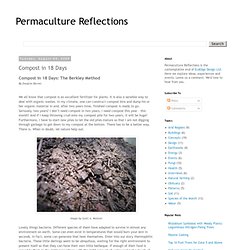
It is also a sensible way to deal with organic wastes. In my climate, one can construct compost bins and dump his or her organic material in and, after two years time, finished compost is ready to go. Seriously, two years? Hot Compost – Composting in 18 Days « Deep Green Permaculture - Iceweasel. Regular composting, also known as “cold composting”, involves placing a variety of organic materials in a compost bin, enclosure, or even just in a large heap, and leaving it there until it breaks down several months later.
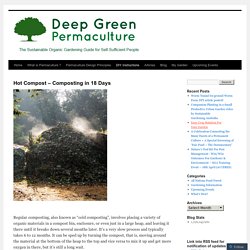
It’s a very slow process and typically takes 6 to 12 months. It can be sped up by turning the compost, that is, moving around the material at the bottom of the heap to the top and vice versa to mix it up and get more oxygen in there, but it’s still a long wait. The other approach to composting is “hot composting”, which produces compost in a much shorter time. It has the benefits of killing weed seeds and pathogens (diseases), and breaking down the material into very fine compost.
In contrast, cold composting does not destroy seeds, so if you cold compost weeds, any weed seeds will grow when you put the compost into the garden. The requirements for hot composting using the Berkley method are as follows: Composting 101 - How to Make Compost. Welcome to COMPOSTING 101, Planet Natural’s go-to guide for making nature’s most rewarding soil amendment.
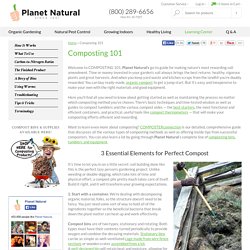
Time or money invested in your garden’s soil always brings the best returns: healthy, vigorous plants and great harvests. And when you keep yard waste and kitchen scraps from the landfill you’re doubly rewarded. You can buy ready-made, organic compost to get a jump start. But it’s easy and inexpensive to make your own with the right materials and good equipment. Here you’ll find all you need to know about getting started as well as maintaining the process no matter which composting method you’ve chosen.
30 Unexpected and Unusual Things You Can Compost. Composting isn't just for food, silly!

You'll be surprised at all the strange, random junk you can toss in the compost bucket. Don't draw the line at peach pits and coffee grounds - start chucking the following items into that bucket and watch your garbage bill go down while you create top-drawer dirt (and help the planet, of course). 1. Bills - because somehow it's a lot more satisfying shoving bills in with melon rinds and egg shells than the recycle bin. Trust me. 2. 3. Magazines 4. 163 Things You Can Compost. A young boy and his father were walking along a beach, when suddenly they came upon thousands of starfish left stranded on the sand by the receding tide.
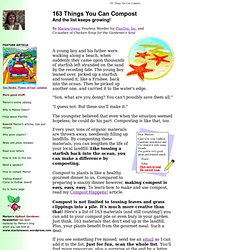
The young boy leaned over, picked up a starfish and tossed it, like a Frisbee, back into the ocean. Then he picked up another one, and carried it to the water's edge. "Son, what are you doing? You can't possibly save them all. " "I guess not. The youngster believed that even when the situation seemed hopeless, he could do his part. Every year, tons of organic materials are thrown away, needlessly filling up landfills. Xeriscape. 2.
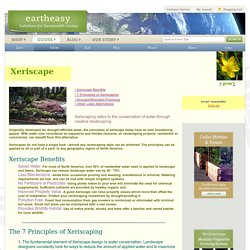
Soil Improvement The ideal soil in a water-conserving landscape does two things simultaneously: it drains quickly and stores water at the same time. This is achieved by increasing the amount of organic material in your soil and keeping it well aerated. Compost is the ideal organic additive, unless your xeriscape contains many succulents and cacti.
These species prefer lean soil. Xeriscape.